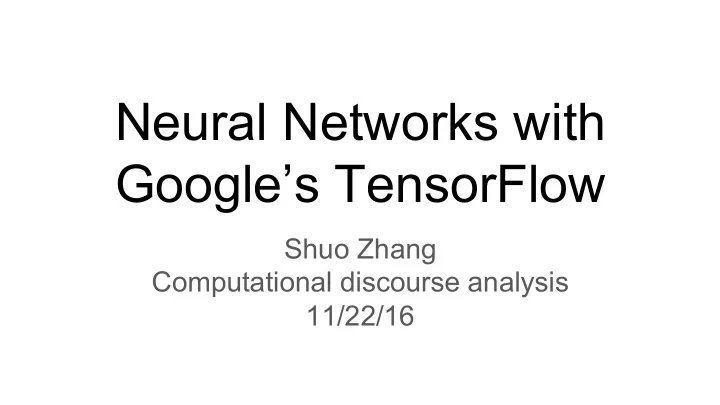

Neural Networks with Google’s TensorFlow Shuo Zhang Computational discourse analysis 11/22/16
Overview 1. Neural Networks basics 2. Neural Networks specifics 3. Neural Networks with Googe’s TensorFlow 4. Coreference: Singleton classification example
Resources • Deep learning course (Google) @ Udacity • Machine learning course (Stanford, Andrew Ng) @ coursera • Neural Network course (Geoffrey Hinton) @ coursera
1. NN basics
From linear to non-linear classifier
Pros and cons of linear models Pros: Cons: Conclusion: • Fast • Limited to modeling We want to use additive features parameters within linear • Numerically stable functions but able to • Multiplicative or higher efficiently do non-linear • Derivative is constant order features leas to mapping. huge parameter space, not suitable for non- linear mapping
From logistic regression to neural networks
Inserting a non-linear layer: Rectified Linear Unit(ReLU)
Intuition: how NN makes non-linear mapping possible
Type of neural network • Feed forward • Feedback • Self Organizing Map(SOM) • ..
2. NN specifics
Multinomial logistic regression as the basic unit in NN
Softmax – turn outputs of linear functions into probability vectors
One-hot encoding
Cross entropy – measuring similarity between prediction and gold label
Putting it together again
MLR to NN
ReLU – a non-linear activation function to put in the hidden layer ReLU is one of many choices of a non-linear activation function. https://en.wikipedia.org/wiki/ Activation_function
Training a neural network • Basically similar to training a linear model by optimizing a convex function using a method like gradient descent • Example cost function for logistic based activation
Cost function – this is universal for linear classifier or NN • Cost function is a function of the parameters that captures the difference between predicted and gold label, therefore we want to minimize it. • How to minimize? Using gradient descent, at each iteration, adjust the weights. • How to adjust weights? Subtracting gradient (derivative) will move you toward the minimum.
Gradient descent • Keep in mind that W is a matrix, so we need to compute partial derivative with respect to each element of W, and sum them up.
Gradient Descent flavors • Batch GD: classic approach, summing over derivative for all training examples at each iteration in order to perform one update to weights, very slow, but more stable, almost never used today • Stochastic GD: only takes one example at each iteration and use the gradient computed from that example to adjust weights, fast, but less stable behavior • Mini-batch GD: (in between) takes a mini-batch of examples (such as from 100 to 2000) and sum up those terms derivatives to perform update, balance between stability and speed (also good results), most used today
Neural Network training: forward backward propagation Intuition from linear classifier: Repeat: • Compute an output • Compute error • Adjust weights (my implementation in Octave)
3. Neural Networks with Googe’s TensorFlow https://www.youtube.com/watch?v=oZikw5k_2FM
Setup https://www.tensorflow.org/versions/r0.11/get_started/os_setup.html
Get started
Hyper parameter tuning (loss curve) • Number of hidden nodes • Learning rate • Batch size • Number of steps • Overfitting
Google Udacity course example:notMNIST
Example code for notMNIST dataset (Udacity) • https://github.com/tensorflow/tensorflow/tree/master/tensorflow/examples/ udacity (This set of ipython notebook is not only partial implementation, since it is meant to be an assignment to be completed. To view a complete implementation, refer to the .ipynb and html files I uploaded on the corpling server).
Recommend
More recommend